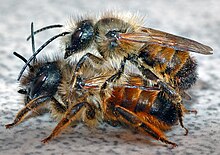Osmia rufa
| Osmia rufa | |
|---|---|
 |
|
| Scientific classification | |
| Kingdom: | Animalia |
| Phylum: | Arthropoda |
| Class: | Insecta |
| Order: | Hymenoptera |
| Family: | Megachilidae |
| Genus: | Osmia |
| Species: | O. rufa |
| Binomial name | |
|
Osmia rufa (Linnaeus, 1758) |
|
| Synonyms | |
|
Osmia bicornis |
|
Osmia bicornis
Osmia rufa or Osmia bicornis is a species of mason bee, and is known as the red mason bee due to its covering of dense gingery hair. It is a solitary bee that nests in holes or stems and is polylectic, meaning it forages pollen from various different flowering plants. These bees can be seen aggregating together and nests in preexisting hollows, choosing not to excavate their own. These bees are not aggressive; they will only sting if handled very roughly and are safe to be closely observed by children. Females only mate once, usually with closely related males. Further, females can determine the sex ratio of their offspring based on their body size, where larger females will invest more in diploid females eggs than small bees. These bees also have trichromatic color vision and are important pollinators in agriculture.
This species is part of the order Hymenoptera, which consists of bees, wasps, ants, and sawflies. O. bicornis is the current scientific name for this bee, although it was formerly known as O. rufa. This bee is a member of the family Megachilidae, which mostly consists of solitary bees, and is among 11 species of Osmia identified in Britain. The three subspecies of O. rufa include O. r. bicornis,O. r. cornigera, and O. r. fractinoris.
O. rufa is about the same body size as the honeybee. Sexual dimorphism is observed in this species; females are larger than males, because the female larvae are provisioned with (and eat) more pollen. Body size in O. rufa decreases as temperature in brood cells increases. Beyond 25 °C, body growth can be severely truncated, leading to small adult body size or mortality. The male and females are also distinguishable by antenna length, with males possessing an additional antenna segment, (characteristic of almost all Hymenoptera).
Males are 8–10 mm long. They have a gray-white tuft of hair on their faces, including on the clypeus.
The females have two horns and darker hairs on their heads, and are 10–12 mm long. Clypeal hairs are absent in females.
O. rufa is found in England, southern Scotland (possibly northern Scotland, as well), Wales, Ireland, mainland Europe, Sweden, Norway, North Africa, Georgia, Turkey, and Iran. Of the 11 species identified in England, O. rufa is both the largest and most common species present.
O. rufa occupies a variety of nesting sites within nature and in sites of human construction. These bees have been known to nest in key holes, empty snail shells, plant stems, and empty beetle hollows.O. rufa occupies the old shells of these three species: Helix nemoralis, Helix hortensis, and Helix pomatia and the nests of Anthophora species. Additionally, these bees make their nests in such sites as sandy banks, decaying trees planted in clay soil like the willow tree, old-mortared walls, flint stone holes, garden shed fifes, and window frame holes and cracks.
...
Wikipedia
